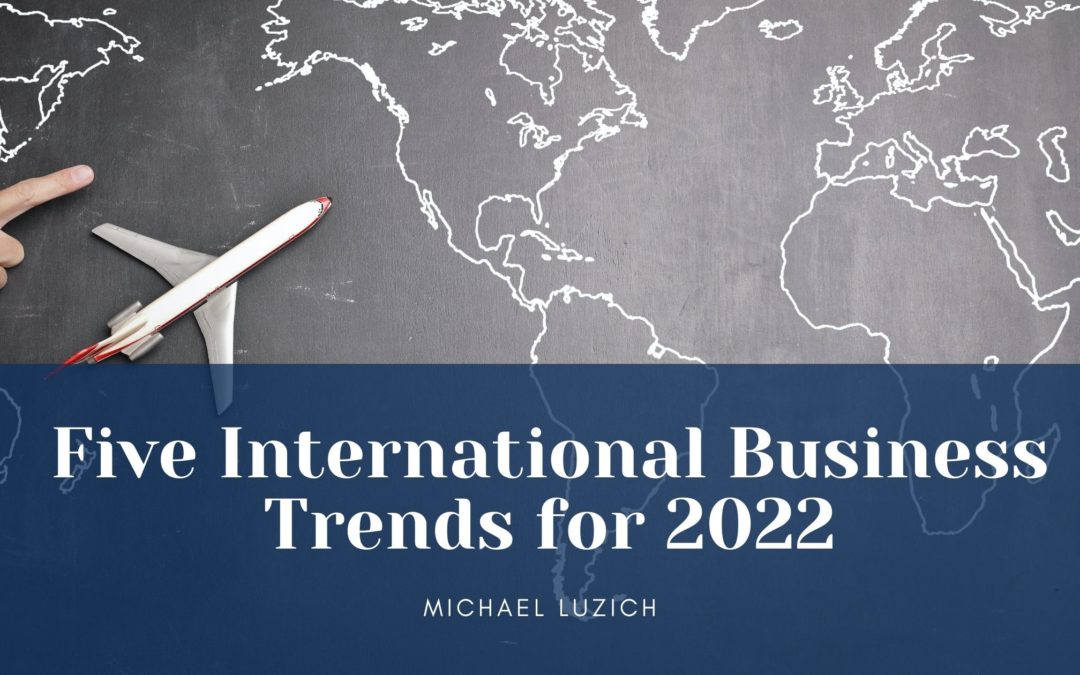Business trends from 2021 will continue into 2022, dominated by growing geopolitical uncertainty, the pandemic and the growing threat of climate change. The following trends are expected to be especially important drivers in 2022:
Strong but Slowing Economic Growth
Economic growth, globally and in the US, broke records in 2021, rising to nearly 6%. The outlook for 2022 is lower, but still strong—estimated to be 4.4%—due to ongoing supply shortages, the effect of the Omicron variant early in the year, and lowered expectations for the United States and China.
Increased International Trade and Trade Agreements
In 2021, global merchandise trade increased by 10.8%. The World Trade Organization expects a 4.7% expansion in 2022. International trade is rising beyond pre-pandemic levels. Major U.S. ports processed almost 20% more container volume in 2021 than they did in 2019. While merchandise sales are surging, services trade is mixed: digital trade will continue to grow rapidly, but the slump in travel and tourism seen since 2020 is expected to persist.
With rising global trade, countries are working to create new trade agreements. On January 1, 2022, the Regional Comprehensive Economic Partnership (RCEP) eliminated more than 90% of trade tariffs among 15 Asia-Pacific nations. The Trans-Pacific Partnership (TPP) is attracting new applicants including the United Kingdom, South Korea, Taiwan, and China, although the US continues to hold out.
Improving Supply Chains
Supply chains remained challenging in 2021, but 2022 holds promise for gradual improvement. Contributing factors in 2021 included:
- COVID-19 outbreaks in manufacturing hubs
- A severe worker shortage
- Increased consumer demand
- Disruption of shipping container cycles
These problems are expected to ease as COVID recedes and the labor market and container traffic stabilize.
Overseas manufacturing organizations are responding to the unstable geopolitical situation and a growing aversion to risk by hedging their supply chain bets. The trend is toward a ‘China plus one’ strategy, with backup and supplementary investments growing in developing near- Eastern and Asian countries such as India, Vietnam, Thailand, Bangladesh, and Malaysia.
Sustainable Energy, Transportation, and Manufacturing
The push for sustainable energy will continue to grow. The global coal industry continues to decline as wind and solar options become more affordable. Infrastructure for electric vehicle charging stations is growing, pushing increased acceptance of and demand for EVs.
Factoring climate change resilience into your business strategy is now imperative. Businesses need to work with their local and national governments to increase investment in renewable and sustainable technologies.
Increasing Reliance on Digital Technology
In 2020, global internet traffic was estimated to be more than 3 zettabytes, or 3 trillion gigabytes; it is forecast to grow by 50% in 2022. New opportunities are coming for companies of all sizes and diverse sectors—including small businesses and service providers—and not just traditional “internet companies.” Federal institutions and small- and medium-sized businesses will increase their focus on adopting modern digital technologies, already in use by all large businesses, to improve efficiency, automate processes, facilitate decision-making, and lower costs. Artificial Intelligence (AI), Machine Learning (ML), cybersecurity, blockchain, and Intelligent Automation (IA) will all benefit. A recent Zinnov survey revealed that almost 50% of enterprises indicate that they intend to increase their spending on digital technology adoption, implementation, and transformation.

